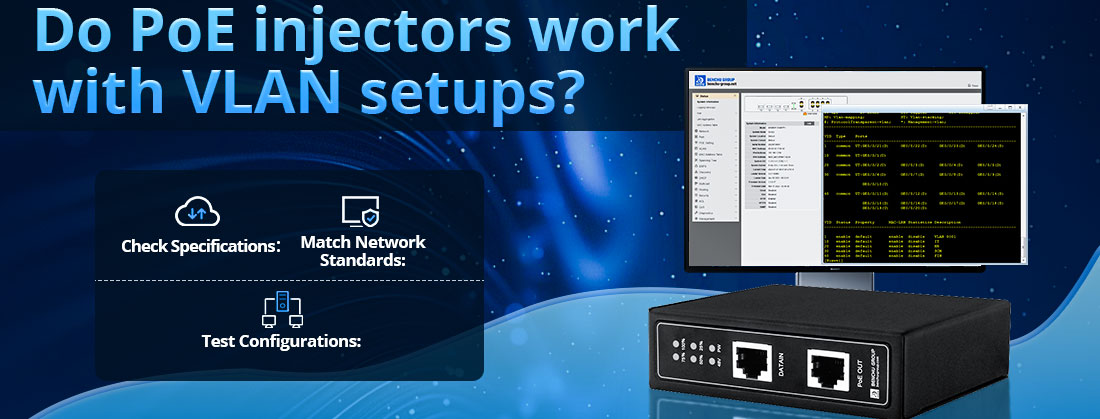
Sim, os injetores de POE trabalham com as configurações da VLAN (Rede de Área Local Virtual), desde que sejam adequadamente integradas à infraestrutura de rede. Como um injetor de POE adiciona apenas energia a uma conexão Ethernet sem alterar os dados, ele não interfere na funcionalidade da VLAN. No entanto, entender como os injetores de POE interagem com as VLANs requer um exame de seu papel na arquitetura da rede.
Como os injetores de Poe trabalham em ambientes VLAN
A Injetor de poe opera como uma fonte de energia de repasse em uma rede. Ele não altera, gerencia ou interage com o tráfego da VLAN, mas injeta energia em um cabo Ethernet enquanto permite que os dados passem inalterados. As configurações da VLAN são tratadas por interruptores de rede, roteadores e pontos de acesso, não pelo próprio injetor do POE.
Poe Injector e Fluxo de dados da VLAN
1. Dados da VLAN marcados ou não marcados: Se um quadro Ethernet marcado com VLAN (seguindo o IEEE 802.1Q) passar por um injetor POE, o injetor não modifica ou remove a tag VLAN. Simplesmente encaminha o quadro junto com a energia injetada para o dispositivo conectado.
2. Injeção de potência no mesmo cabo: o injetor POE adiciona 48V DC Power (ou superior para IEEE 802.3BT) ao cabo Ethernet sem interferir nas estruturas de pacotes VLAN.
3. Switch e Router VLAN Gerenciamento: As funções da VLAN permanecem inteiramente gerenciadas pelo comutador que suporta a marcação, a segmentação e o roteamento de dados da VLAN.
Casos de uso para injetores de POE nas configurações da VLAN
Os injetores de POE podem ser efetivamente usados em redes habilitadas para VLAN para várias aplicações:
1. Pontos de acesso habilitados para VLAN (APS)
--- Muitos pontos de acesso Wi-Fi Enterprise (APS) suportam a marcação da VLAN para separar o tráfego de rede, como redes de hóspedes e corporativas.
--- Um injetor de POE pode fornecer energia a um AP habilitado para VLAN, enquanto a marcação da VLAN é tratada pelo comutador.
2 câmeras IP com segmentação VLAN
--- As redes de vigilância geralmente isolam câmeras IP em VLANs para melhorar o gerenciamento de segurança e largura de banda.
--- Um injetor de POE pode alimentar câmeras que são atribuídas à VLAN, permitindo que o comutador lide com a segmentação de tráfego.
3. Telefones VoIP com prioridade da VLAN
--- Os telefones VoIP geralmente usam VLANs separados (VLANs de voz) para priorizar o tráfego de voz e garantir a qualidade da chamada.
--- Um injetor POE pode fornecer energia aos telefones VoIP sem interromper as configurações de marcação da VLAN ou QoS (QoS).
Limitações e considerações
Enquanto os injetores de POE apoiam as configurações da VLAN, existem algumas considerações importantes:
1. Os injetores de Poe não gerenciam VLANs
--- Os injetores POE são dispositivos somente de energia e não possuem recursos de rede da camada 2/camada 3, o que significa que eles não podem criar, atribuir ou gerenciar VLANs.
2. O interruptor de rede deve suportar VLANs
--- O comutador conectado ao injetor POE deve suportar a marcação da VLAN (IEEE 802.1Q) para que a funcionalidade da VLAN funcione.
3. Use Switches POE gerenciados Para VLANs em larga escala
--- Se sua rede envolver várias VLANs e configurações complexas, uma chave POE gerenciada é preferida sobre um injetor de POE para um melhor controle da VLAN.
Conclusão
Os injetores do POE suportam totalmente as configurações da VLAN porque não interferem na marcação da VLAN ou na transmissão de dados. Eles simplesmente adicionam energia ao cabo Ethernet enquanto permitem que o tráfego da VLAN passe por inalterado. No entanto, a funcionalidade da VLAN é totalmente controlada por dispositivos de rede com reconhecimento de VLAN, como interruptores gerenciados, roteadores e pontos de acesso. Para o Advanced VLAN Management, um interruptor POE gerenciado é tipicamente uma solução melhor do que usar um injetor de POE independente.